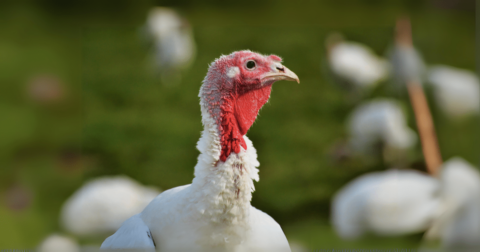Feature
Maine Was First to Ban Spreading PFAS-Contaminated Sludge on Farmland. Now Sludge Is Filling up Landfills.
Health•19 min read
Explainer
The real facts about this American tradition might surprise you.


Words by Jessica Scott-Reid
Serving a turkey for holiday dinner is so common, it might as well be as American as apple pie. Whether it’s for Thanksgiving, Christmas or some other occasion, Americans consumed 5.1 billion pounds of turkey in 2021, with each bird weighing up to 30 pounds or more. Yet this type of poultry wasn’t always synonymous with holiday dinners. It’s one of the many myths about turkeys that proliferate each fall. Here are the facts.
Fact: Turkey farming likely originated in Mexico. While wild turkeys are native to various regions of North America, the Mayans of southern Mexico were likely the first to domesticate turkeys around 2000 years ago, according to The National Audubon Society, an American environmental organization dedicated to the conservation of birds and their habitats.
Historians believe that early Spanish explorers then brought these domesticated birds back with them to Europe. From there, “early European colonists migrating to America’s Atlantic seaboard actually brought domestic turkeys along with them,” writes Michael Stein for Audubon, “completing the circle back to America.”
Yet another myth: there is no indication that turkey was ever even served at the “first Thanksgiving.” In fact, many stories told of that day in 1620 Massachusetts are built around colonialist perspectives, erasing Indigenous versions of events, including the food most Indigenous people in the U.S. typically ate, like corn, squash and beans.
Fact: While turkey meat, like chicken, is lower in saturated fat than beef, it can still contain high levels of heart-harming saturated fats depending on how it is prepared. For holiday meals, turkeys are often slathered with butter before roasting, or deep fried in oil, often consumed with the fatty skin and gravy made from fat drippings. Prepared according to one of those methods, turkey is not a low-fat meal. And deep-frying turkeys can also be a safety risk, as dozens of accidents injuring people and damaging property are reported each year.
Raw or undercooked turkey meat can also be contaminated with salmonella, a potentially deadly strain of bacteria that can spread to humans if they eat or handle meat that isn’t safely prepared. Food safety experts from the CDC, USDA and FDA estimate that over 23 percent of foodborne salmonella illnesses are from chicken and turkey.
Fact: Turkeys are intelligent, emotional and social animals. They’re smart, showing “personality and character, and keen awareness of their surroundings,” said Oregon State University poultry scientist Tom Savage to The Atlantic.
When allowed to, “turkeys enjoy tight-knit families,” according to The Humane Society of the United States. “Not only do broods remain together for up to five months, but male siblings form lifelong social units.”
And turkeys have a refined “language” of yelps and cackles, wrote naturalist Joe Hutto in his book on wild turkeys. They also will mourn the death of a flock member.
Though they may appear funny looking, or even perpetually confused, turkeys are in fact sentient beings with individual wants, needs, thoughts and feelings.
Fact: Beans are the real climate winner. According to the Environmental Working Group, every 4 ounce serving of turkey consumed is the greenhouse gas equivalent to driving a vehicle 2.75 miles. Alternatively, lentils and beans of the same amount are equivalent to driving close to zero miles, while tofu amounts to driving just half a mile. The difference in carbon footprints is in part due to the land required to grow crops needed to feed animals.
Fact: Turkey farming poses many animal welfare concerns. Birds today are grown to be unnaturally large and heavy, which can lead to injuries, particularly to their overburdened feet. Often trapped and crammed into large warehouses, the animals are unable to exhibit most natural behaviors, including roosting and foraging.
The most common method of slaughtering turkeys involves shackling the large birds upside down by their feet, dunking their heads into electrified water, running their necks along a blade before plunging them into a tank of scalding hot water to remove their feathers. This is done by fast-moving assembly lines where mistakes can happen, including improper stunning leading to conscious cutting and scalding.
In the U.S., “humanely raised” labeling claims can be made by any turkey producer who fills out a written application that describes how their animals are “humanely raised,” with a sketch of the label. There is little to no regulatory oversight.
Myths about turkeys — along with their comparatively low price — may explain why Americans consume so many of these birds.
Thankfully there are other options that come with far less cultural baggage, animal suffering and eco-impact. Plant-based holiday meal ideas are abundant online, and ready-made animal-free meals are now common in stores. Traditional meals can evolve and change — and in some cases they must — especially those based on myths to begin with.